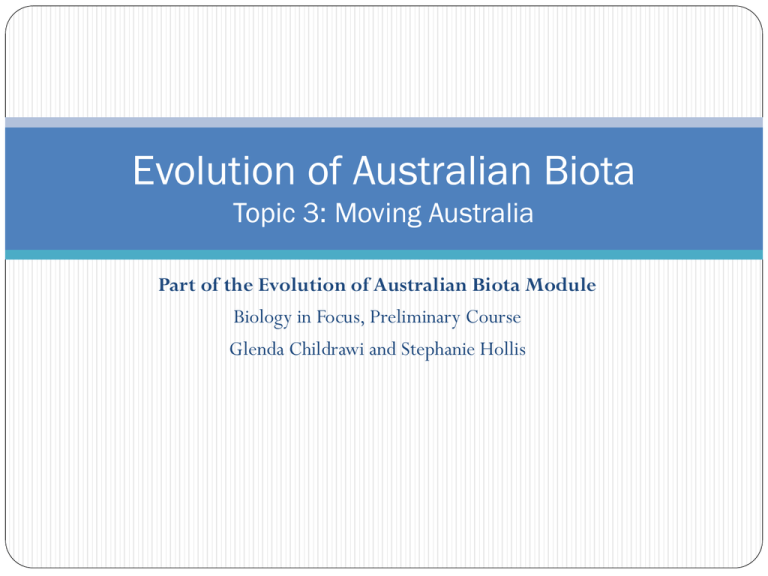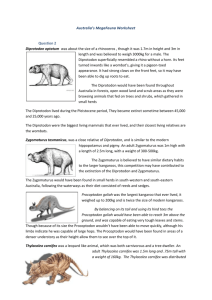1.3 Moving Australia
advertisement

Evolution of Australian Biota Topic 3: Moving Australia Part of the Evolution of Australian Biota Module Biology in Focus, Preliminary Course Glenda Childrawi and Stephanie Hollis DOT Points discuss current research into the evolutionary relationships between extinct species, including megafauna and extant Australian species identify changes in the distribution of Australian species, as rainforests contracted and sclerophyll communities and grasslands spread, as indicated by fossil evidence Discuss current theories that provide a model to account for these changes Moving Australia We know about 300 million years ago (mya) Australia was part of a very large continent called Pangaea. Australia was attached to many other landmasses at that this time. About 150mya this large land mass began to split up. en.wikipedia.org Moving Australia If this history of the movement of the continents is correct, it should explain the current distribution of various plants and animals. There are very few plants and animals found naturally (without the help of people) all over the world. livestream.com Moving Australia Some insects, bats and birds are widespread because they can fly. Coconuts are found in many parts of the world because they can drift over the ocean. All other living things tend to inhabit six separate (biogeographic) regions, there are few species that live in more than one of these. (See 1.3.1 Biogeographical Regions) taxonomy.zoology.gla.ac.uk Moving Australia Although the climate and other conditions may be similar, the animals and plants present are different. Plate tectonics and the theory of evolution provide us with an explanation for the current distribution of plants and animals, especially mammals. bcs.whfreeman.com Moving Australia For example, Australia and nearby islands contains the only monotremes and most of the marsupials found in the world. It is also home to a few native placentals, particularly bats, rats and mice. smh.com.au Moving Australia When Australia and Antarctica separated from Africa and India about 150mya, mammals had only evolved to the point where most in the world were monotremes (lay eggs) or marsupials (have a pouch), there were few placentals (bare live young which are nourished before birth in the uterus). blog.revealedsingularity.net Moving Australia This separation of landmasses isolated these three groups of mammals on our continent. While placentals continued to evolve in the rest of the world, those in Australia became extinct as the Australian continent drifted to its present position and its climate changed. spaceboomerang.blogspot.com Moving Australia About 15 million years ago the part of Earth’s crust containing the Australian continent collided with the one carrying Asia. When this happened, it allowed such placentals as mice and rats to reach Australia by island hopping. music000001.blogspot.com Moving Australia We can also explain the distribution of plants, such as the family Proteaceae. Well known examples include Banksia and Grevillea. The earliest fossils of these plants in Australia date from around 65mya and their current distribution is shown below in red. mobot.org Moving Australia These plants are not readily dispersed and their colonisation of an area depends on land connections. Their current distribution can be explained by the fact that they evolved when the continents were still joined as Gondwana. oldgrayegg.blogspot.com Moving Australia Once the continents separated, parallel evolution took place in their isolated environments. The evolved forms are all similar enough to belong to the family Protaeceae but have developed into a number of different species on each continent. eeb.uconn.edu Megafauna If we could somehow go back to Australia during the Pleistocene around two million years ago, we would find the vegetation reasonably familiar. However, although you would recognise much of the fauna, it would be obvious there was something different. They were big! sydney-stylist.blogspot.com Megafauna Megafauna is a group of animals which includes very large kangaroos, wallabies, wombats, the huge Diprotodon, giant running birds and a giant python. geo-sites.zoomshare.com Megafauna One of the largest herbivores was the Diprotodon, a lumbering marsupial that was the size of a hippopotamus. Another was the cow sized Palochestes with its short tapirlike snout. They served as prey for an equally large group of carnivores. australianmuseum.net.au Megafauna Another member of the megafauna is Procoptodon which is the short faced kangaroo and was around 3 metres tall! It became extinct in the Pleisotcene and is related to the modern day grey and red kangaroos. abc.net.au Megafauna Fossil evidence indicates a giant kangaroo of this time had a diet of meat. Related to the present day musky rat-kangaroos, the powerful-toothed giant rat-kangaroo (Ekaltadeta ima) probably walked on all fours. This giant is estimated to have weighed up to 60 kilograms. crazy-zoologist.livejournal.com Megafauna If marsupial prey escaped from the killer kangaroos, they had to be careful in the forests as well. A 130 kilogram or more marsupial lion could drop from a branch. There were at least 8 known species related to present day wombats and koalas. donsmaps.com Megafauna Also present were the marsupial wolves, doglike animals of the forest floor. The last surviving member of this group was the thylacine, which became extinct in 1936. So what caused the extinction of the megafauna? kidcyber.com.au Megafauna In other parts of the world there is evidence of human involvement in the extinction of animals including the woolly mammoth in the arctic and the Moa in New Zealand. Could humans have caused this? vincentkhoo819.blogspot.com Megafauna As Australia moved towards the equator, the increasing aridity of the climate saw changes in vegetation that affected the populations of herbivores and thus carnivores. This change is apparent at Lake Callobonna, in South Australia, where many fossils of Diprotodon have been found. Now a series of dried out saltpans, Lake Callobonna once had enough vegetation to support a large population of these large marsupials. Was it climate change? panoramio.com Activity -Watch Megafauna Video









